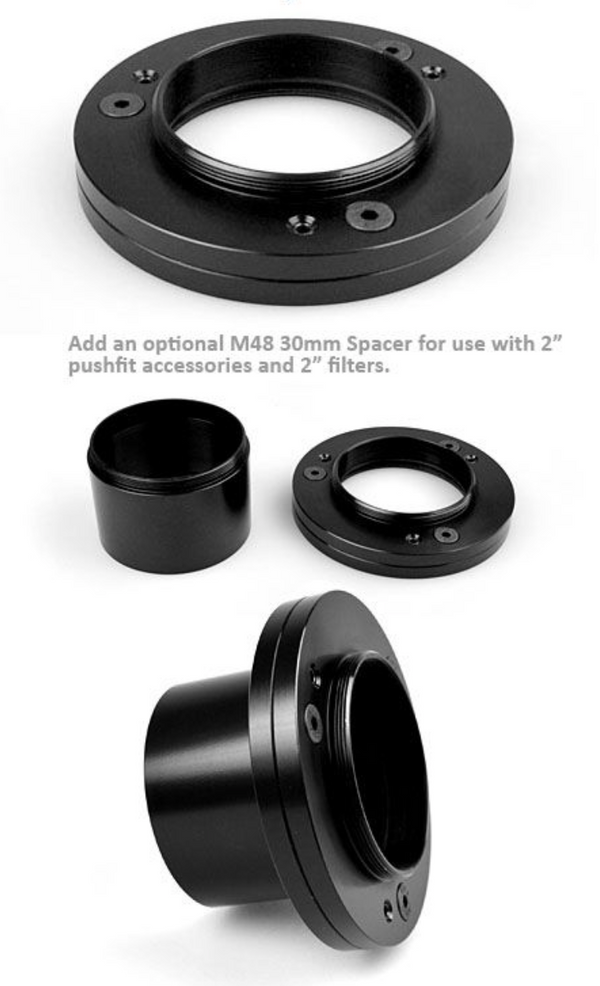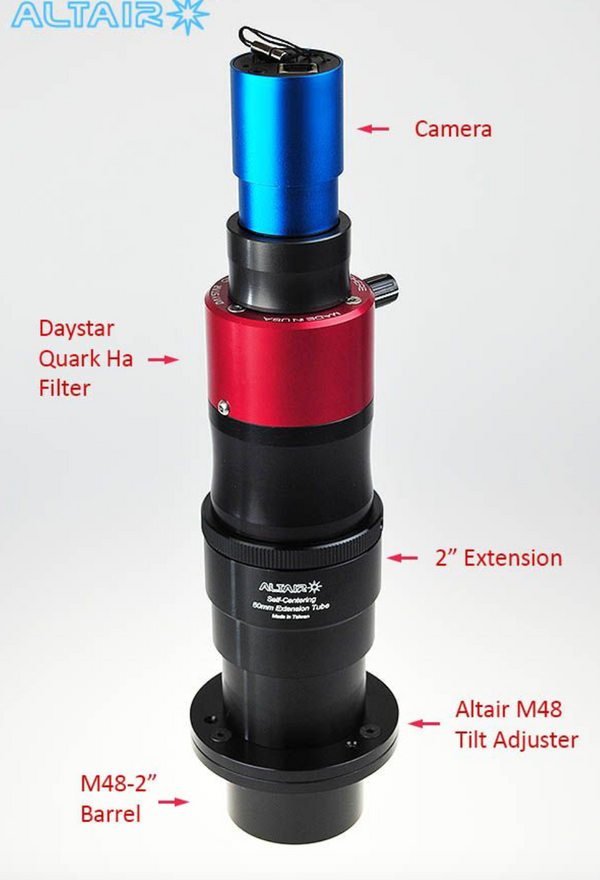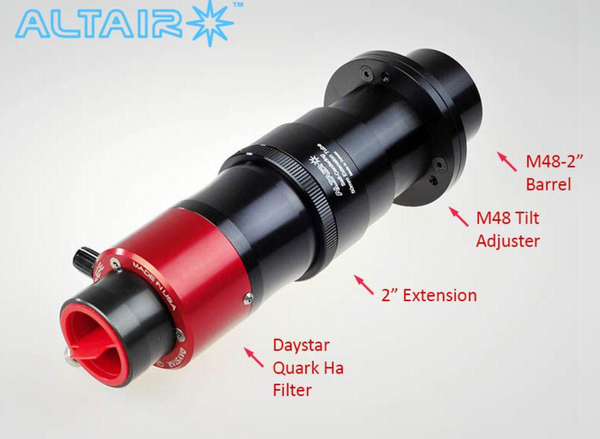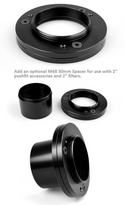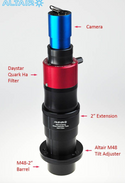The Altair M48 tilt adjuster is designed to give the perfect image field by making the CCD or DSLR camera sensor completely orthogonal to the telescope's optical axis.
For solar imaging with the Daystar Quark or just about any Hydrogen Alpha Etalon filter, the M48 Tilt Adjuster is pretty much a mandatory to solve Newton's Rings or Banding in the image. For visual use it can be used to tune-in and hold the "sweet spot" to get the best preformance from your Quark or any Solar telescope with an Ha Etalon filter.
For deepsky imaging the tilt adjuster is used to compensate for inevitable tilt changes in the "imaging train" when accessories like a filter wheel, focuser, and so-on are used. This gives a more even pattern of star shapes in the image. Especially important when using field flatteners or coma correctors to fine tune the image.
The M48 Tilt adjuster is precision machined in our workshop on a CNC lathe with M48x0.75 male and female threads on each side. (Also known as "astro-filter" thread). It therefore can be used with most extension tubes and adapters. 3 tilt adjustment screws are arranged in a 120 degree opposing pattern. They can be locked in position after adjustment using the corresponding locking screws.
With the camera tilt adjuster, adjustment to fractions of a millimeter are possible for a perfectly flat field with optimal off-axis image sharpness. No more hunting the "sweet spot" for your particular setup, just leave it on! The camera tilt adjuster is ideal for use with larger CCD chips or DSLRs as well as field flatteners and reducers in any fast optical system, where deviation from the focal plane edge is more critical.
The M48 tilt adjuster adds 10-11mm to the light path, depending on the amount of tilt adjustment. Being M48 format on both sides, the camera tilt adjuster is fully compatible with the Altair range of M48 spacers and adapters, and it can be connected directly with most Altair flatteners and DSLR adapters using the wider M48 format. Of course you can convert it to M42 on the camera side by using the M48 female to M42 male step-down adapter.
Q: When is the camera tilt adjuster required?
a) For deepsky imaging with fast focal ratio telescopes: Any train of imaging adapters, flatteners and filters is inevitably slightly tilted from the ideal focal plane due to the combined effect of several accessories all connected together, multiplying the almost invisible tolerances in connections between parts. The combined effect can often be seen at the edges of your CCD or DSLR camera chip. DSLRs often suffer from very slight misalignment too which adds to the effect. Some CCD cameras have built-in tilt adjusters to compensate for this, however most cannot be adjusted once the camera is connected and focused. The camera tilt adjuster is recommended for use with all cameras and flatteners where stars appear slightly different, i.e. elongated or larger and fuzzier one or more of the field edges. It fits between the focuser and telescope. It can be adjusted in real-time for best results, using the easily accessible push-pull collimation screw system at the sides. For the perfectionist, it's possible to use CCD Inspector software to derive the exact amount of tilt as a numerical value, and to adjust it out of your imaging train completely. The tilt adjuster can also be used to centre reflections on the camera cover glass (halos caused by filters look better on-centre) and to manage alignment issues between filter wheel, off-axis-guiders, and other parts of your imaging system. Example setup: Camera > M48 Adapter > M48 Tilt Adjuster > Field Flattener > Focuser
b) For solar imaging with a hydrogen alpha Etalon filter to cure alignment problems:
Firstly Etalons often create artifacts known as "Newton's Rings" and "Banding" in solar images taken with mono and colour cameras. By tilting the camera relative to the Etalon filter these effects can be reduced or eliminated. Example setup: Camera > 1.25" to 2" Adapter > M48 Tilt Adjuster > Quark > Extension Tube > Focuser.
Secondly, focuser sag or mis-alignment of the focuser to optical axis can cause problems: Often the full disc solar image can give uneven illumination and certain off-band areas, causing areas on the solar surface or prominences to appear less contrasty - or sometimes even dissappearing completely. You can use the tilt adjuster before the quark to adjust for the best image to reduce these issues. Example setup: Quark > Extension Tube > M48 Tilt Adjuster > 2" Barrel > Focuser
What types of optical systems are likely to benefit from the camera angle tilt adjuster? Most optical systems will show tilt if it's present, and tilt is more often than not there - if you consider the number of threaded accessories being used! The effects of tilt become more critical with systems such as Newtonians (with or without coma correctors), and for example with fast APOs like the Altair 80mm F6 ED Triplets with Planostar 1.0x flatteners, Starwave 80mm ED and 102mm ED refractors (which operate at F5.6 with their 0.8x reducers in place).
AstronomyBinoculars & ScopesMicroscopesNautical & WeatherMore InfoEvents

